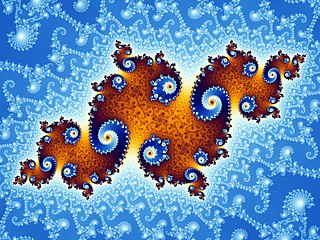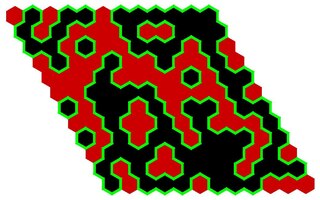
In mathematics, a fractal is a geometric shape containing detailed structure at arbitrarily small scales, usually having a fractal dimension strictly exceeding the topological dimension. Many fractals appear similar at various scales, as illustrated in successive magnifications of the Mandelbrot set. This exhibition of similar patterns at increasingly smaller scales is called self-similarity, also known as expanding symmetry or unfolding symmetry; if this replication is exactly the same at every scale, as in the Menger sponge, the shape is called affine self-similar. Fractal geometry lies within the mathematical branch of measure theory.

The Sierpiński triangle, also called the Sierpiński gasket or Sierpiński sieve, is a fractal attractive fixed set with the overall shape of an equilateral triangle, subdivided recursively into smaller equilateral triangles. Originally constructed as a curve, this is one of the basic examples of self-similar sets—that is, it is a mathematically generated pattern that is reproducible at any magnification or reduction. It is named after the Polish mathematician Wacław Sierpiński, but appeared as a decorative pattern many centuries before the work of Sierpiński.

In mathematics, a Möbius strip, Möbius band, or Möbius loop is a surface that can be formed by attaching the ends of a strip of paper together with a half-twist. As a mathematical object, it was discovered by Johann Benedict Listing and August Ferdinand Möbius in 1858, but it had already appeared in Roman mosaics from the third century CE. The Möbius strip is a non-orientable surface, meaning that within it one cannot consistently distinguish clockwise from counterclockwise turns. Every non-orientable surface contains a Möbius strip.
Experimental mathematics is an approach to mathematics in which computation is used to investigate mathematical objects and identify properties and patterns. It has been defined as "that branch of mathematics that concerns itself ultimately with the codification and transmission of insights within the mathematical community through the use of experimental exploration of conjectures and more informal beliefs and a careful analysis of the data acquired in this pursuit."
In geometry and complex analysis, a Möbius transformation of the complex plane is a rational function of the form

Discrete geometry and combinatorial geometry are branches of geometry that study combinatorial properties and constructive methods of discrete geometric objects. Most questions in discrete geometry involve finite or discrete sets of basic geometric objects, such as points, lines, planes, circles, spheres, polygons, and so forth. The subject focuses on the combinatorial properties of these objects, such as how they intersect one another, or how they may be arranged to cover a larger object.

David Bryant Mumford is an American mathematician known for his work in algebraic geometry and then for research into vision and pattern theory. He won the Fields Medal and was a MacArthur Fellow. In 2010 he was awarded the National Medal of Science. He is currently a University Professor Emeritus in the Division of Applied Mathematics at Brown University.
In mathematics, a Fuchsian group is a discrete subgroup of PSL(2,R). The group PSL(2,R) can be regarded equivalently as a group of orientation-preserving isometries of the hyperbolic plane, or conformal transformations of the unit disc, or conformal transformations of the upper half plane, so a Fuchsian group can be regarded as a group acting on any of these spaces. There are some variations of the definition: sometimes the Fuchsian group is assumed to be finitely generated, sometimes it is allowed to be a subgroup of PGL(2,R), and sometimes it is allowed to be a Kleinian group which is conjugate to a subgroup of PSL(2,R).

In mathematics, iterated function systems (IFSs) are a method of constructing fractals; the resulting fractals are often self-similar. IFS fractals are more related to set theory than fractal geometry. They were introduced in 1981.

In mathematics, an Apollonian gasket or Apollonian net is a fractal generated by starting with a triple of circles, each tangent to the other two, and successively filling in more circles, each tangent to another three. It is named after Greek mathematician Apollonius of Perga.

In mathematics, a Kleinian group is a discrete subgroup of the group of orientation-preserving isometries of hyperbolic 3-space H3. The latter, identifiable with PSL(2, C), is the quotient group of the 2 by 2 complex matrices of determinant 1 by their center, which consists of the identity matrix and its product by −1. PSL(2, C) has a natural representation as orientation-preserving conformal transformations of the Riemann sphere, and as orientation-preserving conformal transformations of the open unit ball B3 in R3. The group of Möbius transformations is also related as the non-orientation-preserving isometry group of H3, PGL(2, C). So, a Kleinian group can be regarded as a discrete subgroup acting on one of these spaces.

In mathematics, a Schottky group is a special sort of Kleinian group, first studied by Friedrich Schottky.
Geometry is a branch of mathematics concerned with questions of shape, size, relative position of figures, and the properties of space. Geometry is one of the oldest mathematical sciences.
The following is a timeline of key developments of geometry:
In the mathematical theory of Kleinian groups, Bers slices and Maskit slices, named after Lipman Bers and Bernard Maskit, are certain slices through the moduli space of Kleinian groups.
In mathematics, a quasicircle is a Jordan curve in the complex plane that is the image of a circle under a quasiconformal mapping of the plane onto itself. Originally introduced independently by Pfluger (1961) and Tienari (1962), in the older literature they were referred to as quasiconformal curves, a terminology which also applied to arcs. In complex analysis and geometric function theory, quasicircles play a fundamental role in the description of the universal Teichmüller space, through quasisymmetric homeomorphisms of the circle. Quasicircles also play an important role in complex dynamical systems.

A conformal loop ensemble (CLEκ) is a random collection of non-crossing loops in a simply connected, open subset of the plane. These random collections of loops are indexed by a parameter κ, which may be any real number between 8/3 and 8. CLEκ is a loop version of the Schramm–Loewner evolution: SLEκ is designed to model a single discrete random interface, while CLEκ models a full collection of interfaces.

Caroline Mary Series is an English mathematician known for her work in hyperbolic geometry, Kleinian groups and dynamical systems.

In geometry, an object has symmetry if there is an operation or transformation that maps the figure/object onto itself. Thus, a symmetry can be thought of as an immunity to change. For instance, a circle rotated about its center will have the same shape and size as the original circle, as all points before and after the transform would be indistinguishable. A circle is thus said to be symmetric under rotation or to have rotational symmetry. If the isometry is the reflection of a plane figure about a line, then the figure is said to have reflectional symmetry or line symmetry; it is also possible for a figure/object to have more than one line of symmetry.













